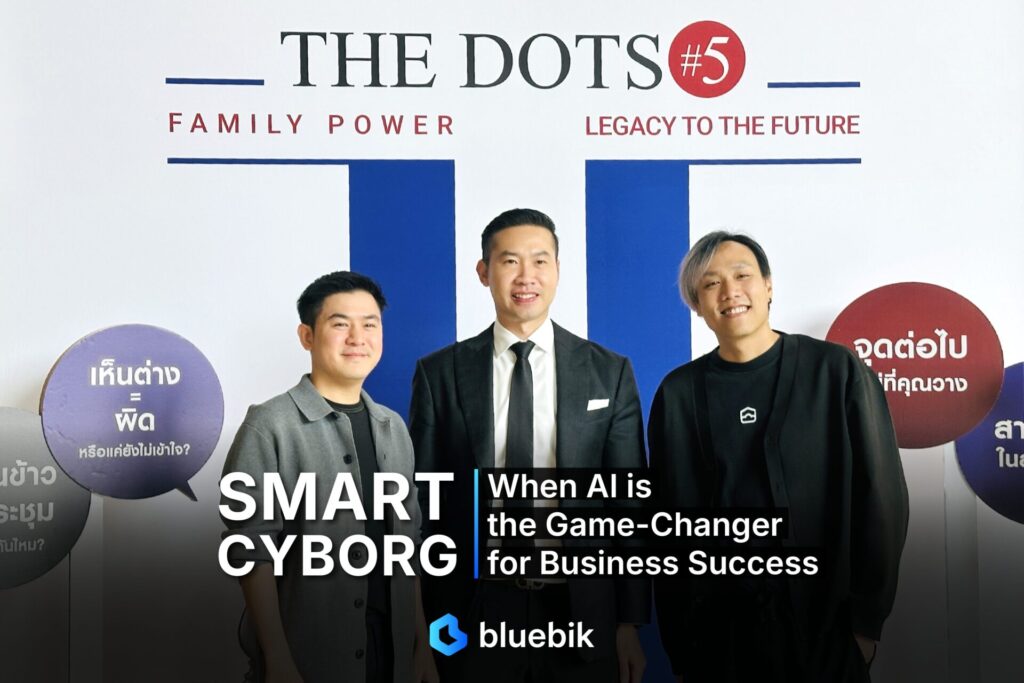In an era when AI is widely accessible, how can businesses maximize the benefits of AI technology?

The answer from Pochara Arayakarnkul, CEO of Bluebik Group, is to become a ‘Smart Cyborg’ – the collaboration between humans and AI that is more effective than using only humans or AI alone.
Pochara Arayakarnkul had the opportunity to share knowledge about business operations and AI usage for SME businesses in the course The DOTs 5th: Family Power – Legacy to the Future by SCB, which aims to support the new generation of SME business successors who want to expand their business to be prosperous, stable, and able to move forward with technology from the foundation passed down through generations.
Besides technology, Pochara Arayakarnkul also shared business management perspectives in various aspects, as someone who has experience building Bluebik Group from tens of employees to thousands of employees and entering the stock market today.
To Build a Successful Business, You Must Understand Your Position
The key to growing a business is to first understand where your business stands, through product and business categorization using the BCG Matrix:
- Star Group: High market share and high growth. Requires full investment for growth.
- Cash Cow Group: High market share but low growth. Reduce investment, focus on maintaining market share and generating cash flow rather than expecting high growth.
- Question Mark Group: Low market share but high growth. Focus on risk diversification, experiment with multiple products or methods to find opportunities to become Star or Cash Cow.
- Dog Group: Low market share and low growth. Should consider change if stuck in this group too long.
- Big Goal: For all groups, start by increasing organizational revenue as the starting point for change.
Key Metrics for CEOs in Different Business Sizes
- Small Business (5-10 employees)
Cash Flow is Key: Must be accurate about cash flow because many businesses fail due to insufficient cash even with profits. Understand Cash Conversion Cycle and credit term management with B2B customers. Main goal is “don’t fail” – even with some losses, can still sustain the business.
- Medium Business (100+ employees)
Profitability Becomes More Important: As cash flow stabilizes, business focuses on profit. Profit reflects future performance, although revenue and expense recognition under accounting principles may differ from actual cash receipt.
- Large Business (1,000+ employees or with subsidiaries)
Management Report/Management Accounting: Extremely important. Must review cost allocation, profitability by product, and separate fixed costs from variable costs. Use this data for strategic decisions such as cutting unprofitable products or restructuring supply chain.
Two Factors to Emphasize When Expanding Business
People
- Challenges: Selection, management, and motivation of employees.
- Expectations: Employees will never be as motivated as owners. Should allow that employees may work at approximately 50% of owner’s capability.
- Build Middle Management: When business grows 3x, middle management is needed to help manage and make decisions.
- Good Incentives: Design appropriate incentives without creating negative effects, such as bonuses not overly tied to sales percentages which may lead to price reductions.
Systems
- Go Paperless: Should have zero paper documents.
- Data Collection: If no system yet, store data in structured format in Excel rather than text or PDF, as it can be more easily extended to ERP systems.
- ERP and accounting systems become more important for tracking and controlling work standards.
Three Principles to Help Business Grow Long-term
- Don’t Underestimate Theory: What we learn from university is valuable if we understand basic principles and know how to apply them in the right context.
- Understand the ‘Why’ of Past Success: When encountering past practices, analyze why those methods worked in the original context and what factors might make them ineffective now, to decide whether to improve in which direction or abandon.
- SME Executives Must Know Deeply: Entrepreneurs should have deep understanding of their business, more than employees and more than external experts, to be able to effectively evaluate and manage those personnel.
Digital Transformation and the Role of AI for SMEs
- Using Tools: Use available functions and tools to their maximum benefit to increase work speed and reduce costs, such as AI or various content creation tools.
- Investment: Focus on investing in education and learning, such as various courses, and experimentation to understand what works and what doesn’t.
- Enhance Efficiency: Use existing tools, such as AI features in Microsoft Office or Google, to increase productivity for all employees.
- Use AI to Create Marketing Content: This can be done in large quantities and quickly, reducing employee workload many times over.
- Assist in Campaign Testing: AI can perform A-B Testing quickly and energy-efficiently.
- Help Reduce Language Barriers: In expanding to international markets.
- Assist with Customer Interaction: Such as checking payment slips or answering customer questions.
- Users Must Use Properly: Don’t forget limitations such as hallucination or creating false information – human verification is always required.
Smart Cyborg: Creating Competitive Advantage in Business
Currently, AI has become widely used technology, but using AI alone may have certain limitations. “Smart Cyborg” is a new concept that emphasizes collaboration between humans and AI to increase efficiency beyond using only humans or AI alone.
Roles of Humans and AI
- Humans are the True Direction-setters: Because humans see opportunities and limitations of their own business.
- Humans are the ‘Users’: Because humans, especially executives, need to know how to use AI in the organization.
- Humans Have Domain Expertise: Because AI cannot have personal data or company-specific information. Humans must apply this information.
- Humans are Effective Prompt Engineers: Training and learning how to command AI beyond basic general methods leads to higher quality and more profound results.
- Humans Should Be Smart Cyborgs: Because collaboration between humans and AI will be more efficient than using only humans as family businesses used to do, and more efficient than using AI alone without human touch.
Creating Organizational Culture for ‘People’ to Be Ready to Adapt
Although technology is a crucial game-changer in creating business competitive advantage, if people in the organization are not ready to adapt and actually use the technology, investment in technology is meaningless.
So how should organizations communicate with ‘people who (may) resist change’?
- Communicate with senior leaders or founders: To create understanding of opportunities and risks, which can be controlled once understood, and demonstrate responsibility for what we’re about to start.
- Communicate with employees through ‘showing by doing’: Focus on using AI in functions that show quick results, such as sales and marketing, to see the impact and make employees confident that it can be done.
- Use understanding: It’s natural for employees to worry or fear job loss. Therefore, communicate to reduce employee concerns by showing them they can use AI in their work, just need to be Smart Cyborgs.
- Create motivation: Design incentives such as increasing employee income or providing visibility and recognition, to make employees want to adapt with the company.
- Close the Skill Gap: Support employees in learning new things, especially older staff, and should use experiential learning methods rather than just sending them to online courses.












